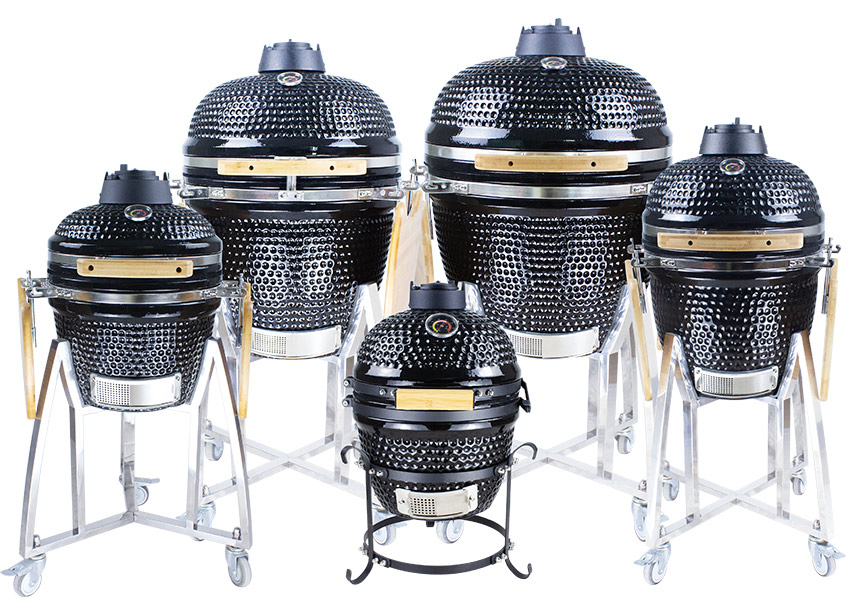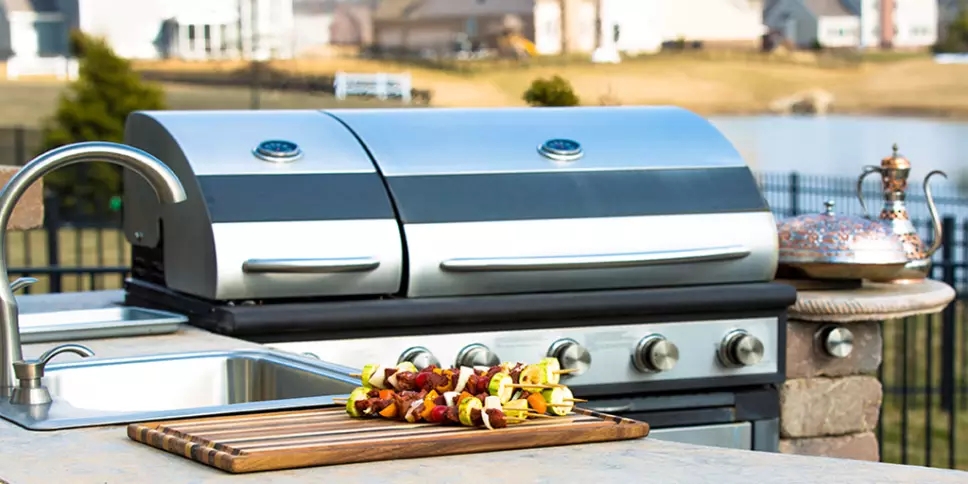5 Types of Grills: How to Choose the Best Grill For You
Learn more about the different types of grills available and how they compare to each other.

We all know there are different heating and fuel sources that can be used while grilling. Each of these fuel sources have their own set of advantages and disadvantages, with some may possibly alter the overall flavor of the food you cooked. Today, let’s take a closer look at some of the different types of grills that utilize each of these fuel sources.
1. Charcoal Grills
Charcoal grills have long been a favorite of outdoor cooks for many reasons. A charcoal grill is easy to use, and foodies crave the smoky, rich flavor which charcoal imparts.
All charcoal grills operate with a few basic similarities. Air intake is located toward the bottom of the grill and is adjusted manually. When air comes into the grill, it passes by the lit charcoal and exits through an additional vent at the top of the grill, similar to a wood-burning stove. The more air that’s allowed to enter and exit the grill, the hotter the grill will get.
One of the benefits of being able to adjust the air intake and exhaust is that once the temperature stabilizes within the temperature zone you wish to cook, it typically remains constant and consistent throughout the cooking process, provided there is enough charcoal to keep it running at that temperature.
This is particularly beneficial when cooking tougher cuts of meat for extended periods of time, which allows them to break down into tender meat with extremely pronounced flavors.
2. Charcoal Kettle Grills
Kettle grills are one of the most commonly recognized types of charcoal grills. They are simple, in the shape of a kettle and consist of not much more than a rounded bottom, a tight, removable lid, stand, and grill grates. Charcoal goes in the bottom of the grill, elevated on a small grate that allows ash and other cooking debris to fall freely away from the heat source and maintain an even airflow over the coals.
One of the main benefits of this type of grill is is how portable it can be. Kettle grills are typically made of metal and are relatively lightweight. They come in different sizes but are mostly portable and typically require less charcoal to use.
3. Kamado Grills
Kamado grills, sometimes called ceramic smokers or “egg grills,” are a more sophisticated version of the charcoal grill and have surged in popularity over the past 10 years. Kamado grills work on some of the same principles of kettle grills but have a few distinct differences.
The kamado grill has a more elongated shape to it, resembling the outline of an egg. They are much heavier than the kettle grill because this type of grill is typically made from a thicker ceramic material and can weigh anywhere between 150-500 pounds, depending on its size.
Air flow and temperature is still regulated through the bottom and top of the just like the kettle grill, but due to its thermal mass and more of an engineered design, even a small adjustment on a kamado grill can make a significant change in temperature. Because of the thickness and weight of the kamado grill, the lid or dome is not typically removed completely, and is connected to the base of the grill with heavy duty, spring-loaded hinges.
Once you get the charcoal started, the kamado grill will typically pre-heat for 45 minutes to an hour to bring its thick walls close to your desired temperature before cooking. It utilizes all-natural, hardwood lump charcoal as a heat source, producing less ash than manufactured charcoal briquettes. Some grilling and barbecue enthusiasts feel the hardwood lump charcoal has the best flavor.
Although kamado grills excel as an extremely hot heat source, the versatility of cooking on them makes them appealing. A common accessory for the kamado grill is a heat deflector. It resembles a thick pizza stone and provides a barrier between the hot charcoal and your food. Using a heat deflector allows this type of grill to cook more like an oven and transfers heat to your food from all directions. This makes for a very consistent heat with fewer hot spots and works well for baking everything from pizzas to cheesecakes; you are limited only by your creativity.
4. Pellet Grills
Although pellet grills have been out for about 30 years now, they have become a hot item in grilling over the past 5 years as a convenient and flavorful option. One of the most appealing things about the pellet grill is that it truly acts as both a smoker and a grill, making the hybrid of the two a fantastic selling feature.
Food-quality wood pellets about the size of a black-eyed pea are loaded into a hopper and are delivered to a burn pot with an auger. Depending on what temperature you set your grill, the thermostat and burn pot work electronically to keep the grill close to your desired temperature. Because the electronic temperature controls are always adjusting to keep the grill within your specified range, there aren’t many adjustments to make once you get the cooker operating to your specifications.
This is convenient, especially with longer cooks like brisket, ribs, and large roasts, allowing that you let the meat cook without too much monitoring. Because of the electronic settings, this type of grill does require a power source which must be connected throughout the entire cook and cool-down process.
Pellet grills have had a reputation for not searing or browning meat as effectively as other grills, but some manufacturers have made great strides in changing the perception of pellet grills and are showcasing recipes with amazing char and grill marks.
5. Gas and Propane Grills
The Hearth Patio and Barbecue Association (HPBA) estimates that 72% of US households have a grill and more than 200 million people can enjoy outdoor cooking. Natural gas and propane grills make up the majority of these grills and there are many styles to choose from.
Gas and propane grills all operate similarly, with burners typically emitting around 40,000 BTUs of heat, firing on three, four, or more burners to cook your food from below with either direct or indirect heat.
Part of the appeal of gas grills is that they are convenient, they heat up fast, and there are many accessory options available to enhance the cooking experience. Accessories such as side burners, lights, integrated food thermometers, and dedicated meat searing areas combine gadgets and gimmicks, and the industry is always adding new innovations.
Gas grills, like gas stoves, are instantly on and require the shortest amount of pre-heating before you can start grilling. This is convenient, but gas burns very clean and will add little additional flavor compared to charcoal or pellet grills.
What’s your grilling style?
Before you decide which kind of grill is best for your lifestyle, consider your space and cooking style.
- Is your deck or patio wired or within range of an extension cord? Without a plug-in outlet, a pellet grill is not going to be the ideal choice.
- Are you feeding a small army? Consider some of the gas options with lots of cook space and side burners for keeping everything from baked beans to chili or chowder ready to serve whenever the gang is ready to eat.
- Do you have space and proper support for a heavy grill? A kamado is a commitment, in terms of weight and space, depending on the size. But, it’s a fantastic grill to choose.
- Do you grill on the fly? If spontaneity is your style, a slow-heating and stabilizing grill probably isn’t a good fit.
- Are you a purist who wouldn’t dream of serving a burger without grill marks and a smoky flavor? Gas may not bring the best flavor, but it is clean, affordable, and fast to get to temperature.
Any inquiry for Kamado BBQ Grill, please contact us:Aidan@auplexbbq.com
Post time: Sep-22-2021


